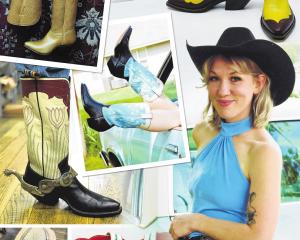
The runway event is a celebration of the 2022 graduating class’s collections. Fashion writer Katie Day talks to students about their work.

The dimly-lit audience, dressed with looks of curious anticipation, sat side by side, framing an illuminated runway.
A clock’s countdown kept time, elevated upon projector screens above the catwalk, to herald the annual fashion show’s commencement.
The atmosphere hummed with eager support of beloved graduates, while an awareness of the meaning and risk involved in gathering as a community lingered.
A faint thread of trepidation tempered the vibrant hum, though caution was exceeded by celebration.
A rhythmic bass-led track reverberated through closely seated bodies, as the first model stepped out, traversing the runway with musicality.

Natural fibres such as linens, chambray denims and cottons spoke to a strong sustainability ethos resonating amidst the students and design school. Garments developed by the second year cohort exhibited considered textile explorations, offering contemporary ideations of embroidery, felting and print.
Colour cohesively connected the first and second year designs, offering a smooth yet intriguing blend of soft 70s tones, found in tans, creams and soft chambray blues, textured by nostalgic 90s plaids, blacks and reds.
As the bass notes subsided, Otago Polytechnic’s Head of the College of Art, Design and Architecture, Frederico Freschi,offered gratitude for the event and community that contributed to such. He spoke of the significance of the 31 year-old fashion show, and its status as the last fashion show to be held under the Otago Polytechnic banner before the national polytechnic merger, forming technical institutes under the head of Te Pukenga.

Many third-year collections captured the psyche of lockdown explorations, with notes of reimagined realities and worlds of escape. The line-ups ranged from gaming-inspired streetwear to Game of Thrones-referencing garments, complete with scales, to numerous, voluminous, corset-featuring occasion-wear collections. Other collections drew from tacit experiences of the designers reality, developing upon personal reflective references or critiques of contemporary society.

Minnie Fry
Hagyatek, meaning "inheritance" or "legacy", is a ready-to-wear collection of sustainable clothing inspired by Hungarian folkwear. The purpose of this collection was to draw more attention to traditional Hungarian garments and craftsmanship and to honour my Nana’s memory. I designed this collection to be long-lasting, environmentally conscious, and culturally accurate. While I did want to modernise traditional folkwear in a way that would make it fashionable, I didn’t want to encroach on the original meanings and techniques used. I did this by keeping the hand embroidery and headdresses, which indicate marital status, as well as incorporating some pleated skirts and an apron, which are key features in Hungarian outfits.

Jess Long
Women are sexualised regardless of their attire. Female empowerment is intrinsic to my practice, and the female friendships formed throughout my study have fostered my passion for feminism. The materials range from opaque to sheer, to manifest the idea that women can wear whatever they are comfortable wearing. The garments can be worn to be as exposing or as modest as desired. Crochet was a new challenge for me this year and the physical engagement required enhanced my understanding of the medium. How a woman wants to present herself is her choice; a concept facilitated by my collection.

George Park
My graduate collection "The Nature of Mercury" details a metamorphic creature as they adapt to survive different groups of perpetrators. How the minority adapts to survive the majority — by exploiting their features to blend in. Stored in the subconscious and reflected in the self.

Francesca Flynn
"The Colonial Wedding" is inspired by my journey of whakapapa and reconnecting to my iwi, Ngai Tahu. This collection emphasises the impact of colonialism in Aotearoa. Gazing through the lens of Christianity, to explore the reality of indoctrination and the explicit extermination of Maori culture — to the impact this has on Maori wahine today. As a designer, my process is focused on experimenting with textile manipulation and unconventional materials, implementing techniques such as laser cutting, etching, heat moulding and glasswork — to push the limits of the materiality of fashion.












